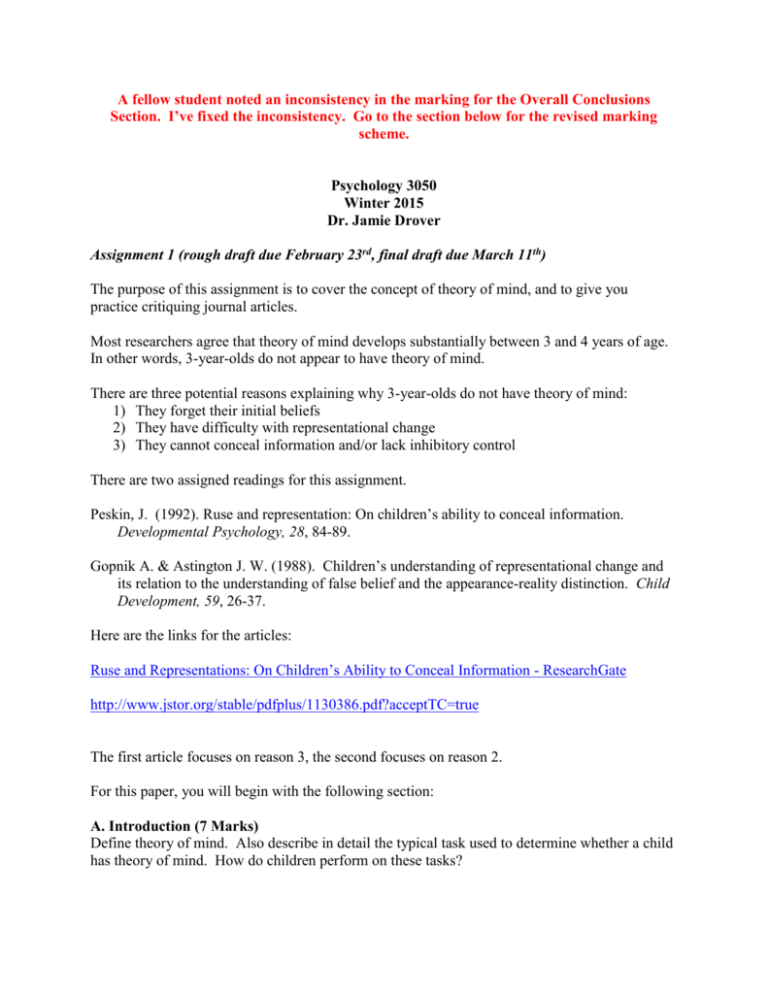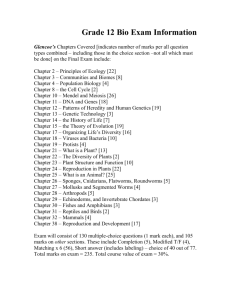updated assignment 1..
advertisement

A fellow student noted an inconsistency in the marking for the Overall Conclusions Section. I’ve fixed the inconsistency. Go to the section below for the revised marking scheme. Psychology 3050 Winter 2015 Dr. Jamie Drover Assignment 1 (rough draft due February 23rd, final draft due March 11th) The purpose of this assignment is to cover the concept of theory of mind, and to give you practice critiquing journal articles. Most researchers agree that theory of mind develops substantially between 3 and 4 years of age. In other words, 3-year-olds do not appear to have theory of mind. There are three potential reasons explaining why 3-year-olds do not have theory of mind: 1) They forget their initial beliefs 2) They have difficulty with representational change 3) They cannot conceal information and/or lack inhibitory control There are two assigned readings for this assignment. Peskin, J. (1992). Ruse and representation: On children’s ability to conceal information. Developmental Psychology, 28, 84-89. Gopnik A. & Astington J. W. (1988). Children’s understanding of representational change and its relation to the understanding of false belief and the appearance-reality distinction. Child Development, 59, 26-37. Here are the links for the articles: Ruse and Representations: On Children’s Ability to Conceal Information - ResearchGate http://www.jstor.org/stable/pdfplus/1130386.pdf?acceptTC=true The first article focuses on reason 3, the second focuses on reason 2. For this paper, you will begin with the following section: A. Introduction (7 Marks) Define theory of mind. Also describe in detail the typical task used to determine whether a child has theory of mind. How do children perform on these tasks? Then you should have the following sections for each paper: B. Method (15 Marks: Peskin 5 Marks; Gopnik & Astington 10 Marks) What was the purpose of the study (Look in abstract or at the end of the intro)? Who did they test? What did they do? C. Results (12 Marks: 6 per Study) What did they find? D. Strengths and Weaknesses (10 Marks: 5 marks for each paper) Provide strengths and/or weaknesses for each paper (should add up to five). E. Conclusions (10 Marks: 5 marks for each paper) What were the conclusions based on the results? F. Overall Conclusion (10 Marks in all) Describe how each of these articles would explain the poor performance of 3-year-olds on theory of mind tasks. Which article’s explanation do you believe? Provide a good argument as to why you believe one explanation is better than the other. Here’s how it breaks down: 2 marks per study for their explanation as to why 3-year-olds fail theory of mind tasks. 2 marks for picking a study to support. 4 marks for reasons why you support that study. The cover page and all citations and headings should be done using APA style. Purdue OWL: APA Formatting and Style Guide







